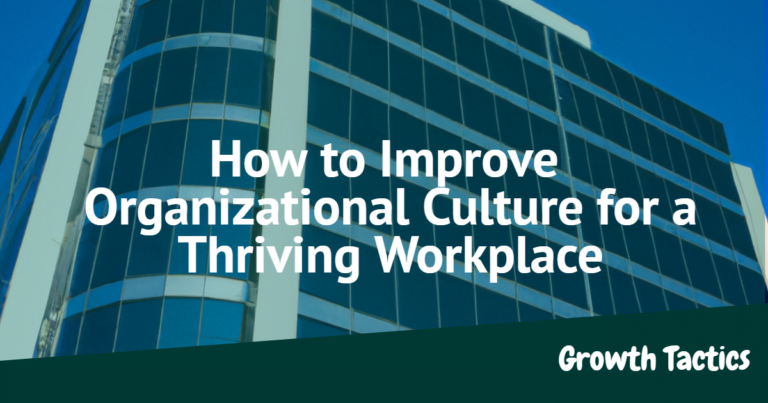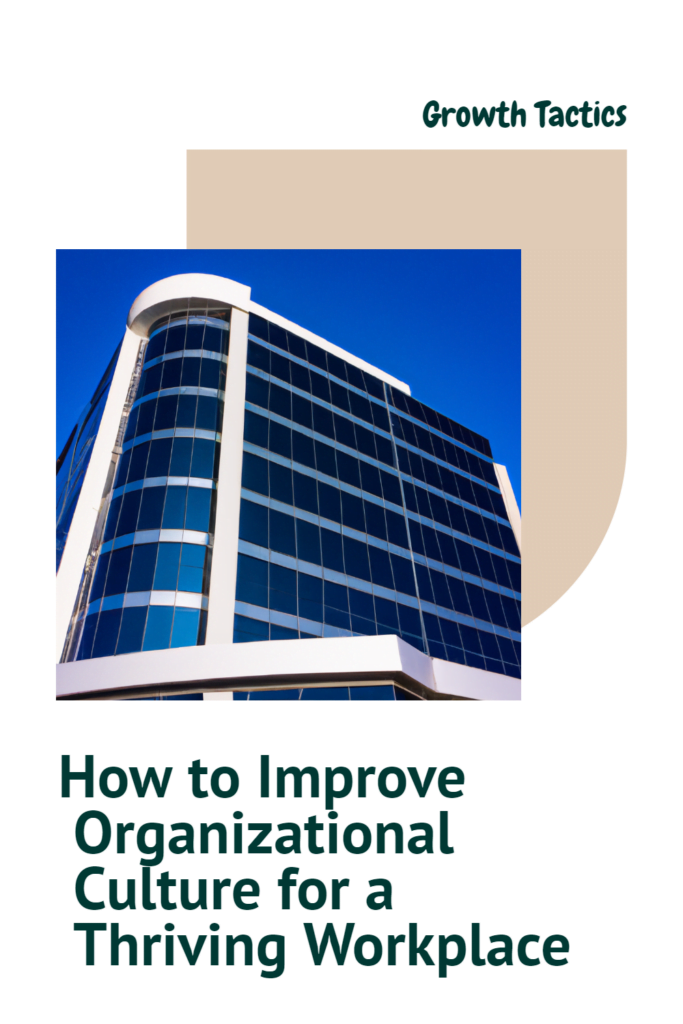In my two decades of leadership, I have witnessed firsthand the transformative power of organizational culture. A strong, vibrant culture can elevate an organization to new heights, unlocking potential, innovation, and a sense of unity that propels the business forward. On the flip side, I’ve also seen how a toxic work environment can unravel the fabric of an organization, eroding trust, stifling growth, and ultimately leading to its downfall.
This stark contrast has illuminated the critical importance of fostering a positive and robust company culture. It’s not just an aspect of business strategy; it is the heart and soul of a thriving organization.
In this blog post, I’ll share actionable insights to improve organizational culture, drawing from years of experience on both sides of the spectrum, to help create a workplace where excellence is not just pursued but achieved.
Jump To Section
Why Company Culture is the Social Glue of Your Business
The concept of company culture is much more than a buzzword, it’s the social operating system of a business. Company culture is critical because it can either invigorate your workforce or lead to a disengaged team. From employee experience to productivity, everything is touched by the company’s values and the environment created within the workplace.

Assessing Organizational Culture: Strategies and Insights
Assessing the pulse of your organizational culture is paramount to understanding its current state, identifying areas for positive change, and strategizing for future improvements. Given the intangible nature of culture, this might seem like a daunting task. However, with a structured approach and the right tools, leaders can gain valuable insights into their organization’s cultural landscape. Here are strategies and insights drawn from years of expertise in leadership and organizational development:
1. Employee Surveys & Feedback
The most direct way to gauge the organizational culture is through employee surveys and feedback mechanisms. These should be designed to measure various aspects of the culture, such as job satisfaction, alignment with company values, understanding of organizational goals, and perceptions of management. Anonymous surveys allow employees to express their honest opinions, providing leaders with unfiltered insights into the organizational climate.
- Pulse Surveys: Short, frequent surveys that help track the impact of any recent changes or interventions.
- Annual Culture Surveys: Comprehensive surveys are conducted yearly to assess deeper cultural elements and employee engagement.
2. Focus Groups and Interviews
While surveys can provide quantitative data, focus groups, and interviews offer qualitative insights. Conducting interviews with employees at different levels and hosting focus groups can help uncover the nuances behind the survey results. These discussions often reveal deeper insights into employee experiences, attitudes, and perceptions that may not come through in survey responses.
3. Observation and Participation
Leaders and HR professionals should participate in and observe daily interactions and organizational rituals firsthand. How do teams collaborate? Are meetings inclusive? Is feedback encouraged and acted upon? Observing the day-to-day life of your organization can provide a wealth of information on its cultural dynamics.
4. Review of Organizational Artifacts
Organizational artifacts, like mission statements, onboarding materials, and internal communications, can reflect the espoused values and culture of an organization. Reviewing these materials in conjunction with employee perceptions can highlight gaps between stated and lived values, guiding leaders on areas that require alignment.
5. Turnover and Exit Interviews
Analyzing patterns in employee turnover and conducting exit interviews can reveal a lot about the culture. High turnover rates in specific departments or under certain leaders can be indicative of unhealthy cultural dynamics. Exit interviews are a valuable resource for understanding why employees leave and how they perceive the organization’s culture.
6. Performance and Productivity Metrics
Though not a direct measurement of culture, performance and productivity metrics can serve as indicators. For example, departments with a strong culture of collaboration and effective leadership often show higher productivity and achievement of goals.
Implementing Cultural Assessment Findings
Collecting data on organizational culture is only the first step. The real challenge lies in implementing the findings to drive positive change. Post-assessment, leaders should:
- Communicate Results: Share the findings with the entire organization, highlighting both strengths and areas for improvement.
- Develop Action Plans: Create targeted action plans to address the identified cultural issues. This may include leadership training, revising company policies, or implementing new communication platforms.
- Engage Employees in the Process: Encourage employee participation in shaping the actions to improve the culture. Their involvement not only ensures that the initiatives are grounded in actual needs but also builds a sense of ownership and commitment among employees.
- Monitor Progress: Regular follow-up and reassessment are crucial to understand the impact of interventions and adjust strategies accordingly.
Tips to Improve Organizational Culture
Improving the organizational culture of a company is a transformative process that requires commitment and strategic actions. Based on my two decades of experience in leadership, here are some proven tips that can help you cultivate a healthier, more productive work environment:
Foster Transparent Communication
A cornerstone of any strong company culture is open and transparent communication. Encourage your managers and team leaders to communicate clearly and openly with their teams. Regular town hall meetings, open forums, and anonymous feedback tools can help maintain transparency. This proactive communication helps in preempting conflicts and misunderstandings, while also making every team member feel valued and heard.
Recognize and Celebrate Achievements
Recognition is a powerful motivator and plays a pivotal role in building a positive organizational culture. Celebrate both small wins and major milestones and make sure this recognition happens at all levels of your organization. Implementing employee recognition programs, such as Employee of the Month, can also boost morale and encourage a culture of excellence and appreciation.
Promote Diversity and Inclusion
A diverse and inclusive workplace not only fosters innovation and creativity but also ensures that all employees feel like integral parts of the organizational fabric. Develop diversity programs and training sessions that promote inclusion across all echelons of your company. An inclusive culture invites varied perspectives and ideas, which are crucial for problem-solving and driving the company forward.
Invest in Professional Development
Employees are more likely to be engaged and committed when they see investment in their growth and development. Offer training, workshops, mentoring, and coaching to help employees advance their skills and careers. When employees see a clear path for growth, they are more likely to be motivated and contribute positively to the organizational culture.
Encourage Work-Life Balance
Respect for personal time and boundaries significantly contributes to employee satisfaction and retention. Encourage your team to maintain a healthy work-life balance by offering flexible working hours or the option for remote work. This not only shows that you care about their well-being but also builds loyalty and commitment.
Build a Culture of Trust
Trust is fundamental to any relationship, and this is especially true in the workplace. Build trust by practicing what you preach, being consistent, and standing firm on your company’s core values. When employees trust their leadership and their colleagues, it creates a safer and more cooperative work environment.
Regularly Evaluate and Adapt Your Corporate Culture
Organizational culture is not static; it evolves with the people and the times. Conduct regular assessments of your company culture through surveys, interviews, and informal discussions. Be open to making the necessary adjustments to keep the culture relevant and aligned with both company goals and employee needs.
Lead by Example
As a leader, your behavior and attitude set the tone for the rest of the company. Demonstrate the qualities you wish to see in your employees, such as integrity, diligence, and positivity. When leaders exemplify the company’s values, employees are more likely to emulate these behaviors, reinforcing the desired organizational culture.
Establish a Sense of Purpose
Employees are more engaged and motivated when they understand how their work contributes to the company’s mission and objectives. Clearly communicate your company’s vision and regularly reinforce how each team’s efforts play a crucial part in achieving that vision. Create a narrative that connects daily tasks to the bigger picture, making work more meaningful and purpose-driven.
Create Opportunities for Collaboration
Foster a culture where collaboration is valued over competition. Encourage cross-departmental projects and create spaces—both physical and digital—that promote teamwork. Implementing collaborative tools and platforms can also facilitate smoother communication and idea-sharing across different teams, enhancing productivity and innovation.
Advocate for Employee Well-being
Promote a holistic approach to employee well-being that goes beyond just physical health. Implement initiatives that support mental health, such as mindfulness sessions, stress management workshops, and access to counseling services. Recognizing the importance of mental health in the workplace not only supports employee well-being but also sets a precedent for a compassionate and understanding work culture.
Lead with Empathy
Leadership that demonstrates empathy fosters a more supportive and inclusive culture. Take the time to understand the challenges and aspirations of your team members. Empathetic leadership involves active listening, showing genuine concern, and offering support, which can significantly boost employee morale and loyalty.
Encourage Innovation and Creativity
Cultivate an environment where innovation and creativity are not just encouraged but celebrated. Encourage employees to think outside the box and experiment with new ideas without fear of failure. Create innovation labs or dedicate time for team brainstorming sessions to explore new possibilities. Recognizing and rewarding creative efforts reinforces a culture of continuous improvement and innovation.
Focus on Building Resilience
In an ever-changing business landscape, resilience is key to navigating challenges and uncertainties. Encourage and develop resilience by fostering a mindset of adaptability and learning from setbacks. Celebrate recoveries and pivots as much as successes, emphasizing that resilience is a valued trait within the company culture.
Prioritize Ethical Practices
A culture grounded in ethics and integrity not only earns the trust of employees but also that of customers and partners. Ensure that your company’s values explicitly include ethical practices and that these are reflected in every aspect of the business operations. Conduct regular training on ethical behavior and ensure that there are channels for anonymously reporting unethical actions.
Leverage Technology to Enhance Culture
In today’s digital age, technology plays a pivotal role in shaping organizational culture. Utilize technology to streamline workflows, foster communication, and promote engagement. From collaboration tools to platforms for recognizing employee achievements, technology can be a powerful ally in building and maintaining a strong company culture.
Foster a Culture of Continuous Learning
Instill a mindset of lifelong learning by providing access to educational resources, online courses, and professional development programs. Encourage employees to pursue learning opportunities and share their knowledge with their peers, creating a culture that values growth and continuous improvement.
Involve Everyone in Workplace Culture Efforts
Finally, remember that shaping a positive organizational culture is a collective effort. Involve employees at all levels in discussions about culture and values. Create Culture Committees or Task Forces that are representative of the entire workforce to lead initiatives and gather feedback. When everyone has a stake in the culture, it becomes a shared vision that everyone works towards.
Conclusion
Improving organizational culture is not just about making changes—it’s about transforming mindsets and habits. By embracing these tips and continuously seeking ways to improve company culture, you can craft a work environment where employees thrive, innovation flourishes, and the company prospers. Remember, cultivating a positive company culture is an ongoing process that shapes the success of both individuals and the organization as a whole.


